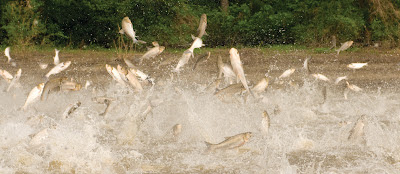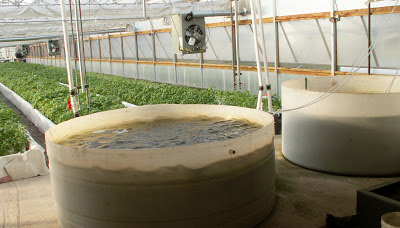A closer look at web tools and sites that boost research and empower Great Lakes communities to secure a healthy environment and economy.
.png) Aquaculture plays an increasingly vital role in securing long-term food supplies, and the Midwest is poised to help. In fact, a rich supply of raw materials and proximity to large markets makes Illinois and Indiana prime locations for aquaculture farms and related industries.
Aquaculture plays an increasingly vital role in securing long-term food supplies, and the Midwest is poised to help. In fact, a rich supply of raw materials and proximity to large markets makes Illinois and Indiana prime locations for aquaculture farms and related industries.
To help producers cash in on these benefits, IISG, University of Illinois Extension, and Purdue Extension teamed up to create Aquaculture Economics and Marketing Resources. The site provides leading research and how-to information for developing a productive, innovative, and profitable aquaculture business.
Visitors interested in starting a new business will find resources on everything from establishing an organizational structure to creating a business plan to securing financing. New and veteran producers can also find tips for connecting with consumers and tapping into niche markets.
Aquaculture Economics and Marketing Resources is one of several tools IISG uses to help aquaculture producers define markets and create value-added opportunities for their products. Since 2005, Kwamena Quagrainie has held roughly 40 workshops with over 1,200 participants. These and other efforts in Indiana resulted in about $15 million in farm sales of aquaculture products in 2013, a nearly five-fold increase over 2005.
To learn more about how aquaculture is strengthening Indiana’s economy, read our 2013 program impacts.
Category:
Website of the week: The ABCs of fish farming
January 21st, 2015 by iisg_superadminIn the news: Aquaponics could revolutionize urban eating
March 11th, 2013 by Irene MilesIllinois-Indiana Sea Grant, along with several other Sea Grant programs, universities, and researchers, have been involved in advising and establishing a number of aquaculture operations in the U.S. and around the world, including some aquaponics facilities. This video from our friends at Purdue University provides a terrific amount of detail about aquaponics and how the process could help sustainably grow food.
With the ability to grow plants and fish in a mutually beneficial system, aquaponics presents an especially viable and sustainable option to provide healthy and locally grown food for urban areas.
From The Atlantic Cities:
“Aquaponics is a method of combined fish and vegetable farming that requires no soil. The farmer cultivates freshwater fish (aquaculture) and plants (hydroponics) in a recirculating water system that exchanges nutrients between the two. Wastewater from the fish serves as organic fertilizer for the plants, while the plants clean the water of fish feces and urine. The net result: a 90 percent reduction in freshwater use compared with conventional fish farming, and a significant reduction in added nutrients such as fossil fertilizers. The system can be run without pesticides and, because the fish environment is spacious and clean, without antibiotics…In the lab, the pumps made gushy sounds at regular intervals. The water dripped. As the plants’ leaves evaporated moisture, I could hear the place breathe. I picked a ripe, red tomato from a vine. This lab, I sensed, could morph into an urban oasis: a lush, breathing organism inside the city. Unlike static green spaces like parks, this would be an actual farm as well as a place of tranquility in the city — not to mention a space that could generate the food to feed that city, with minimal harm to the environment or human health, just steps from residents’ tables.”
Follow the link above to the complete article, and visit our aquaculture webpage for more information.
Aquaponics and food farming take over abandoned Chicago factory
August 6th, 2012 by Irene Miles“The transformation is already underway and over the next few years, the factory will become a zero-energy, food business incubator, research facility, education space, and working urban farm. Plant Chicago is already growing greens and mushrooms and will soon start brewing beer and kombucha and raising tilapia in a sustainable system with zero waste.”
In the news: Worldwide fish populations headed towards depletion?
May 24th, 2012 by Irene Miles“Between 1950 and 2006, the WWF report notes, the world’s annual fishing haul more than quadrupled, from 19 million tons to 87 million tons. New technology — from deep-sea trawling to long-lining — has helped the fishing industry harvest areas that were once inaccessible. But the growth of intensive fishing also means that larger and larger swaths of the ocean are in danger of being depleted.”
Invasive fish could be a food solution for Haitians in need
May 10th, 2012 by Irene Miles Sometimes, what can be considered a problem in one area of the world might prove to be a solution to a problem somewhere else on the globe. One such case is the use of Asian Carp as a high-protein food source for Haitian children impacted by the devastating earthquake in January of 2010.
Sometimes, what can be considered a problem in one area of the world might prove to be a solution to a problem somewhere else on the globe. One such case is the use of Asian Carp as a high-protein food source for Haitian children impacted by the devastating earthquake in January of 2010.
“Some innovative thinking is now turning the problem fish into a high-quality protein source for the children at Zanmi Beni, run by Operation Blessing International. Researchers at NOAA’s Louisiana Sea Grant program and the Louisiana State University (LSU) AgCenter have successfully produced canned Asian carp pleasing to the Haitian palate. Ultimately, the product could deliver high-quality protein to people in need, be a boon to fishermen, provide a new opportunity for canneries, and reduce the population of an unwanted invasive species.”
Louisiana Sea Grant Fisheries Specialist Julie Anderson attended IISG’s Asian Carp summit and was able to network with several people including Carol Engle of the University of Arkansas. Carol’s work had involved developing a USDA-approved process for canning Asian Carp, making it possible to safely prepare, store, and ship the food where it was needed.
Recent News
- Tomas Höök signing off as Illinois-Indiana Sea Grant director this summer
- Illinois-Indiana Sea Grant welcomes Stuart Carlton as the program’s new director
- Four Illinois and Indiana educators will set sail on Lake Michigan aboard EPA’s research ship
- Join IISG as a new pollution prevention outreach assistant
- Beach season means it’s time for lifesaving Lake Michigan water safety resources
IISG Instagram
The Shipboard Science Immersion educators worked together to simulate sonar mapping and uncover the secrets of a mystery seabed, just like real underwater archaeologists!
This hands-on lesson mirrors the work of Dr. Ashley Lemke from University of Wisconsin Milwaukee who studies paleo landscapes below Lake Michigan by collecting sonar data from lakebeds. Experiences like these can be shared with youth to spark curiosity and connect them to real-world science in action.
#LakeMichigan #GreatLakes

15 educators from 7 Great Lakes states have boarded the R/V Lake Guardian for a week of science on Lake Michigan!
Day one was all about meeting fellow educators and the science team from the @epa_greatlakes, @uwmilwaukee, and @purduefnr, and getting shipboard safety training.
This hands-on program, supported by the Great Lakes Restoration Initiative, helps bring Great Lakes science into classrooms and builds educator-scientist partnerships.
Follow along as we explore water quality, food webs, and even underwater archaeology!
#GreatLakes #LakeMichigan

Ready for a party? Join us on the newly-expanded Wild Mile for a celebration of our urban waterways and thriving park spaces. Enjoy local beer, food trucks, and an outdoorsy prize drawing while learning about local environmental nonprofits and volunteer opportunities! This event is free and fun for all ages!
The block party is rain-or-shine, and we`ll only cancel in the case of hazardous weather!
This year’s community partners include @Openlands, Current Water, @chicago_enviro, @cleanupclub_chicago, @chicago_birder, Blazing Star School, @cubillinois, Friends of the Bloomingdale Trail, @chicagoshapers, @reducewastechicago, Southern Utah Wilderness Alliance, and @honeycombproject!
Learn more at the link in bio.

📢 Show Your Support for Sea Grant! 📢
Continued federal funding for Sea Grant in FY26 is crucial, and we need your help to demonstrate the nationwide support for these essential programs.
🖊️ Sign the letter urging Congress to continue funding Illinois-Indiana Sea Grant and all 34 state Sea Grant programs:
🔗 https://forms.gle/7sPGHGyh8j8a7vfGA or link in bio

Categories
- Aquaculture
- Aquatic Invasive Species
- Buoys
- Climate Ready Communities
- Director's Blog
- Education
- Featured
- Fellowships
- Fisheries
- Funded Research
- Funding
- Great Lakes Cleanup
- Great Lakes Data
- Healthy Waters
- Internships
- Jobs
- K-12 Education
- News
- Photos
- Program
- Recreation & Tourism
- Resources
- Sea Grant Scholars
- Stormwater & Green Infrastructure
- Sustainable Community Planning
- The Helm
- Uncategorized
- Video
- Water Resource Economics

